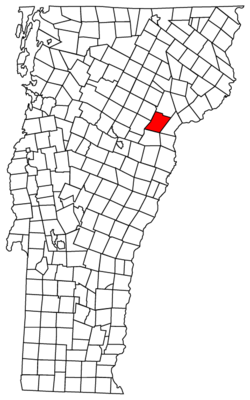Peacham, Vermont
| Peacham, Vermont | |
|---|---|
| Town | |

Peacham Congregational Church
|
|
 Location of Peacham in Vermont |
|
| Location in the United States | |
| Coordinates: 44°20′N 72°11′W / 44.333°N 72.183°WCoordinates: 44°20′N 72°11′W / 44.333°N 72.183°W | |
| Country | United States |
| State | Vermont |
| County | Caledonia |
| Area | |
| • Total | 47.7 sq mi (123.5 km2) |
| • Land | 46.6 sq mi (120.8 km2) |
| • Water | 1.0 sq mi (2.7 km2) |
| Elevation | 1,526 ft (465 m) |
| Population (2010) | |
| • Total | 732 |
| • Density | 16/sq mi (6.1/km2) |
| Time zone | Eastern (EST) (UTC-5) |
| • Summer (DST) | EDT (UTC-4) |
| ZIP code | 05862 |
| Area code(s) | 802 |
| FIPS code | 50-54400 |
| GNIS feature ID | 1462171 |
| Website | www |
Peacham is a town in Caledonia County, Vermont, United States. The population was 732 at the 2010 census.
In 1763, Governor Benning Wentworth of New Hampshire gave a charter for the region to a group of proprietors, and the town was given the name Peacham (it is unclear exactly where this name came from). The original proprietors were speculators who surveyed the town, laid a few rudimentary roads, and divided it into lots, though the territory remained unsettled for some time.
In 1775, settlers, primarily from Connecticut and Massachusetts, bought the lots and built homes, developing the land for agriculture. The original settlers survived almost entirely through subsistence farming despite the long winters, hilly terrain, and rocky soil. Nine years later, records show a population of approximately 200 people. The first recorded town meeting took place in 1784, and selectmen were duly elected to govern the affairs of the town. Peacham was early on presented with a choice of having either the county courthouse or the county school, and the residents voted for the school. In 1795 the Caledonia County Grammar School received its charter, and the first school was established in a log structure on the Bayley Hazen Road, halfway between Peacham Corner and South Peacham.
In 1799, a library was established, which traveled from store to store. A congregational church was founded in 1794 – the first pastor, Leonard Worcester, was well known for his fiery sermons. His son, Samuel Worcester, later went on to be an important missionary to the Cherokee people, creating the first typeface for the Cherokee alphabet and gaining lasting fame as the plaintiff in the supreme court case Worcester v. Georgia.
Early residents, who came to be known as Peachamites, traded butter, eggs, and wheat for goods which they could not make at home, and also relied on the production and sale of items such as whiskey and potash to help augment the relatively poor harvests. Almost from the beginning various trades and industries—as many as 30-35 at a given time—flourished. Lumbering, coopering, milling, butter making, tin ware, tanneries and leather goods provided goods for local consumption. From 1800 to 1830, sheep farming flourished as a more profitable endeavor than growing crops. In 1840, the town reached its greatest population of 1,443. From that date on, census numbers steadily declined. Farming methods changed, and dairy farming came to replace sheep. The larger more industrially advanced farms of the late 19th century could not support large families, and youth began to leave home.
...
Wikipedia

